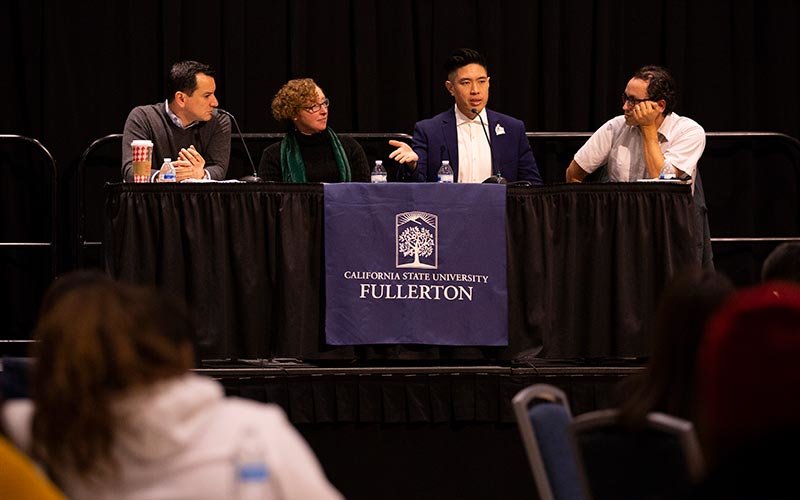
One of Anthony Rendon’s top priorities when he became speaker of the California State Assembly was civic engagement. With a goal of bringing state government and topics relevant to Californians to college campuses, the Cal State Fullerton alum, ’82, ’94 (B.A. political science-public administration, M.A. political science), moderated a Dec. 5 discussion at his alma mater focusing on the multicultural culinary scene of California.
Why food?
“Food lends itself to community and there’s no better place than Orange County to see this,” he said. “Orange County is the doorstep to the multicultural experience.
“Orange County is having a moment,” he continued. “Not only was it the center of the political universe this past election, but the fusion of cultures, and thus food, makes this the perfect place to have this discussion. And we have really great food here.”
Panelists for the event were Elaine Margaret Lewinnek, professor of American studies at Cal State Fullerton; Patrick Nguyen ’07 (B.A. business administration-marketing), owner of The Straw: Modern Milkshakes in Costa Mesa; and Gustavo Arellano, author and writer for the Los Angeles Times, who has spent years exploring the communities and subcultures of Southern California.
Lewinnek studies and teaches a class about food at the university. “I look at the history of food and how the foods we enjoy often have a darker side. When Chinese food became popular, we had exclusion laws. People meet over burritos and then talk about building a wall. Did you know that fortune cookies aren’t really Chinese? They were developed in southern Japan and introduced to America at Golden Gate Park in 1910. In the 1940s, the Japanese were interned, and then the Chinese took over making fortune cookies.”
“It is ironic that often we demonize the people whose food we love,” said Arellano. “For instance, you have Neo-Nazis who meet at Mexican restaurants. They love the food. But my hope is that first you conquer the stomach, then the heart and then the brain.”
Rendon recalled the first time he walked into The Straw: Modern Milkshakes shop. “It was the coolest milkshake shop I’d ever been to,” he said. “Patrick’s mother ran a traditional Vietnamese restaurant next door and it led to my thinking about generational differences.”
“My parents always owned restaurants so I grew up in that industry,” said Nguyen. “I wanted to be an artist but I majored in marketing. What I found amazing is that my mother knew how to make delicious food but she didn’t know how to market it. I watched her work so hard and I wanted to help and start my own business.”
“You do see cultures merging through food,” Lewinnek said. “If you want truly authentic Mexican food, you’d have no flour tortillas or pork. The Aztecs didn’t eat that. Bagels are considered Jewish food and while Jews in America eat bagels, you’d find it difficult to find a bagel in Israel.”
“Food is easy to teach,” she said. “Because we care about it. There is a history to everything — menus, recipes, pineapples…. And look where Southern California is in relation to the world. We are a borderland with Mexican and Central American influences. We also have food and culture from the Pacific Rim. And since we focus heavily on tourism and services, it stands to reason that our food would be influenced by multiple cultures.
“Interestingly, when I was living abroad, students asked me to fix them an American meal and I was stumped. Is there anything inherently American about our cuisine? Spaghetti? No, that’s Italian. Hamburgers? Even the name is German. For me, American food was homemade soup and bread because that’s what my mother made. But that’s MY perspective. The only thing I could really land on was peanut butter,” she laughed.
“What does seem American is the idea of someone else preparing our food,” she continued. “We frequently eat the food that others have prepared. We are under time pressures, and did you know that Americans eat more of their meals in their cars than people in any other country?”